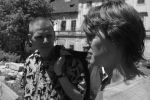Entarctic Shelf Festival: 23 June – 3 July, 1995
Globe Work was one of two pieces made by Roi Vaara in Plasy. It was performed late at night in the summer refectory. With one naked light bulb hanging from the ceiling on a long cable, Vaara stood before a wall and a niche where there used to hang a crucifix by Mathias Braun. Vaara played with inflatable plastic globe. This innocent playfulness became gradually more and more agressive and the performer finally destroyed the ball, mimicking the famous scene from the Chaplin film The Great Dictator (1941).
Description
The performance took place in what was originally the dining room of the monks, where a huge crucifix hung on the wall. After the monastery ceased, the space served as granary, and a new floor above the ground floor was built. There was an opening in the middle of the new floor for a wooden funnel.
The space is dark. The performer slowly pulls the electric cable down from the ceiling and the light bulb simultaneously rises up from inside the funnel, slowly, until it is above floor level, where it stops. The performer stands next to an inflated balloon with a world globe printed on it. He wanders around the globe, pushes it and rolls it around on the wooden floor.
It begins in silence, but gradually various national anthems are heard. The performer opens the air valve of the balloon globe. The anthems gradually get louder as the air escapes from the globe. The performer handles the globe more aggressively. He kicks it around the room and against the crucifix. The excerpts from the anthems get shorter, more fragmented and broken up. Silence follows as the air has all escaped from the balloon.
The performer catches hold of the electric cable above the light bulb, and then moves the light over to the side wall and lets it swing. The monastery bells begin to ring. The performer moves to the middle of the floor, faces the crucifix, and cuts his forehead horizontally with a piece of broken glass. He then turns toward the audience. He stands motionless while his forehead bleeds a little and his shadow swings from one side of the crusifix to the other like the hand of clock. The swinging arc of the light-bulb pendulum gradually shortens, and the bells stop ringing. The pendulum then stops and the shadow of the performer is cast upon the crucifix.
Roi Vaara, August 2017
Roi Vaara (1953) is a pioneer in video, installation, performance and collective arts in Finland and internationally best known of his performances. His background is in visual arts and in improvisational sound works. As soon as his elemental groundwork in his art became clear to himself, he rejected the conventional genre based art disciplines to work on site and situation specific interdisciplinary art forms made live. He has done performances since 1978 and since 1988 he has been active in a performance collective Black Market International whose mode of operation is based on free and open exchange of ideas.
Roi Vaara has performed over 500 unique, experimental works. His art has been presented in numerous international exhibitions/festivals in about 50 countries worldwide. He is one of the founders of Muu ry (1987), an association for interdisciplinary art in Finland and its honorary member since 2012. He has written about art, worked as visiting lecturer and teacher in numerous universities and art academies around the globe, curated and organized performance art programs. Poikkeustila (Exceptional State or State of Alarm) in 1999 was the first and until now the only nationwide performance art festival in Helsinki. In 2001 Vaara organized EXIT Festival called as Woodstock Festival of Performance Art which presented works of about 300 artists from 34 countries in Helsinki. His performance Artist's Dilemma (1997) on video became an international hit and the emblem of 47th October Salon in Belgrade subtitled as Art, Life & Confusion (curated by René Block) in 2006.
Roi Vaara was born in 1953 in Moss (Norway) from Finnish parents, studied art in University of Art and Design (now Aalto University) in 1972-75 in Helsinki and in Jyväskylä University 1976-77 in Finland. He was granted a state award from the Arts Council of Finland in 2000 and the Niinistö Foundation's Ars Fennica Prize in 2005. In 2010 he was nominated (by Esther Ferrer) to 5x5 CASTELLÓ International Art Prize and was awarded Pro Finlandia Medal of the Order of Lion in Finland. Roi Vaara lives and works in Helsinki and Budapest.





